Peter Datin, Derek Stedman, and Holly Widen
Peter Datin is a Director - Model Development at RMS
Derek Stedman is a Lead Modeler - Model Development at RMS
Holly Widen is a Product Manager at RMS
Log In
Access all customer product support, event response, and training in one place
LifeRisks PortalFind modeling tools based on best practice actuarial techniques and medical science
Miu PortalExplore analytics and risk insights for the alternative capital market
Insurance Solutions
Formerly Moody’s RMS
Peter Datin, Director, Model Development, RMS
Derek Stedman, Lead Modeler, RMS
Holly Widen, Product Manager, RMS
Introduction
Hurricane Michael made landfall in the Florida Panhandle near Mexico Beach on October 10, 2018, as the strongest hurricane (by wind speed) to impact the area in recorded history. As a strong category 4 hurricane, Michael’s wind speeds were at or above the design-level wind speeds for this area specified by ASCE 7 and the Florida Building Code. Figure 1 below shows the RMS HWind 3-second peak gust footprint with the design wind speed contours from ASCE 7-16 for Risk Category II structures (e.g., single-family homes and most commercial structures).
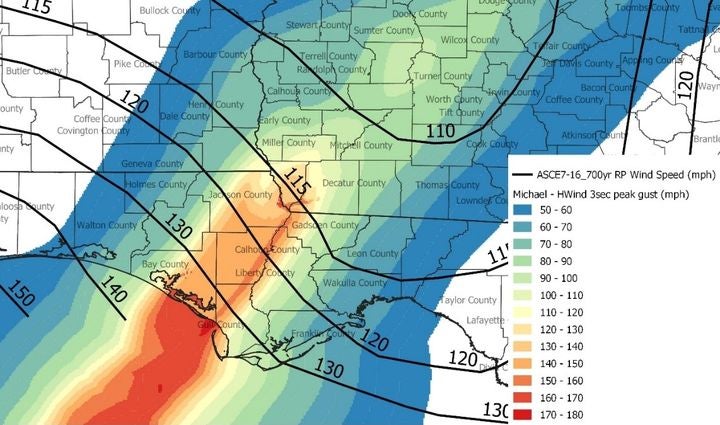
The Florida Panhandle has historically considered itself less prone to intense hurricanes than other coastal areas such as the Greater Miami Area, where the probability of category 4 and 5 storms is much higher. As an example, in the history of the Florida Building Code (FBC), the Panhandle successfully lobbied for an exception to the windborne debris provisions that were introduced in the original 2001 FBC. This exception was ultimately lifted in 2007 but highlighted that this area contained many examples of pre-FBC construction side-by-side newer construction built to higher standards, featuring wind damage mitigation measures suggested by the engineering community and organizations such as the Insurance Institute for Business and Home Safety (IBHS).
Hurricane Michael Damage Observations
RMS’ team of engineers visited the affected region immediately after Michael made landfall. We surveyed the damage along the coastline and throughout the affected areas in the Panhandle and southern Georgia from October 12-15, 2018, and captured the following findings.
Treefall
The affected region has dense tree cover with mostly pine and oak trees, which can be both a blessing and a curse during storms. At lower wind speeds, the trees shield structures from the wind, reducing damage. At higher wind speeds, however, falling trees on structures can amplify damage substantially.
Treefall damage from Michael was notably different than in other recent storms, like Harvey (2017), Matthew (2016), and Irene (2011), in that most of the trees were snapped at the trunk due to high wind speeds instead of being uprooted due to saturated soil. Treefall was also a major contributor to the widespread windborne debris and missile impacts.

Structure and Roof Age
The year that a structure was built, and the age of its roof cover are major drivers of building performance when exposed to wind speeds at design level. The two houses shown in Figure 3 below are right next to each other in Mexico Beach, just outside the surge affected area. The older home on the left, built in 1965, suffered wall failure and total roof loss. The newer home on the right, built in 2015, suffered only minor damage to its vinyl siding, soffits, and screens. Almost all of the older properties in the neighborhood were destroyed, asserting the effectiveness of newer building code provisions.

Metal Roofs
Another interesting observation about the damage from Michael was the mixed performance of metal roofs. We noticed significantly more metal roof failures in the Panhandle compared to those experiencing similar windspeeds in South Florida after Irma (2017). The main reason for this discrepancy was the differences in the type of metal roofs and their installation methods.
As shown in Figure 4 below, the house on the left had a properly installed Standing Seam Metal Roof (SSMR), which survived the storm completely intact. However, the house next to it on the right, also with a metal roof, sustained significant damage. Closer inspection revealed the house on the right had more of a corrugated metal roof in terms of installation as the metal panels were not crimped together, which is the distinctive feature of SSMRs. Thus, it was not able to withstand the high wind loads imposed by Michael.
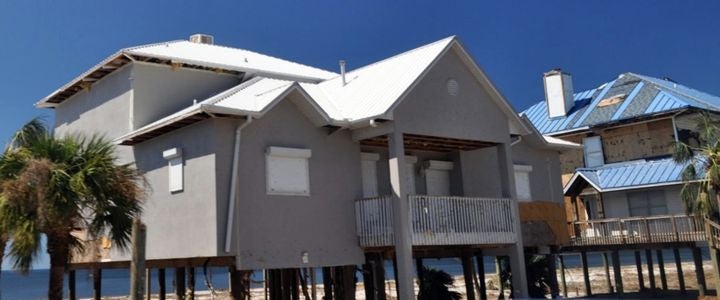
We noted many such instances of metal roof failures in Michael with most cases exhibiting metal panels installed on top of old asphalt shingles. While some properties had metal panels installed directly on the shingles, others had wood strips between the shingles and the metal roof. Regardless, this prevalent type of installation did not seem to perform adequately when exposed to design level winds.
Foundation Issues
Along the coast between Port St. Joe and Mexico Beach, we observed poor foundation connections on many residential properties with catastrophic damage. Figure 5 below shows foundation anchor bolts that were completely rusted and bent. In some cases, as evident in the picture on the right, corrosion reduced bolt thickness to only a couple of millimeters, which then offered no resistance to high wind and surge loads and led to dramatic foundation failure.
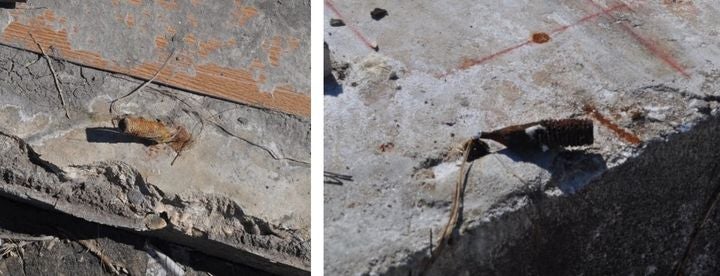
Figure 6 below shows a home near Port St. Joe that moved off its foundation in surge waters due to inadequate connections consisting of small metal clips and nails installed only on the outer foundation beams. Many of these connections were rusted and not strong enough to hold the house in place.
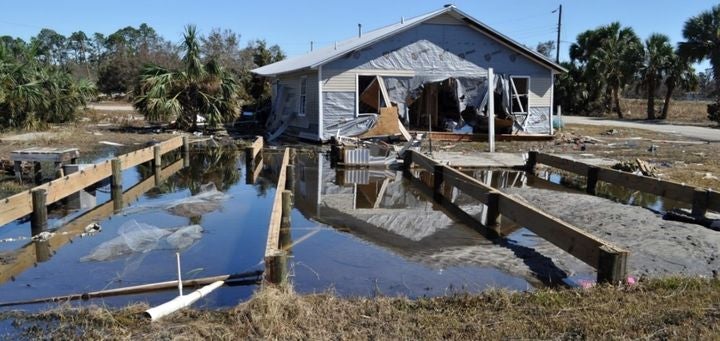
Figure 7 below shows an example of a house that did not have any physical connection between the floor and the short masonry foundation wall, such as steel reinforcement, bolts, or metal straps. As a result, lower surge water heights were sufficient to lift and move the house off its foundation, leading to total loss.
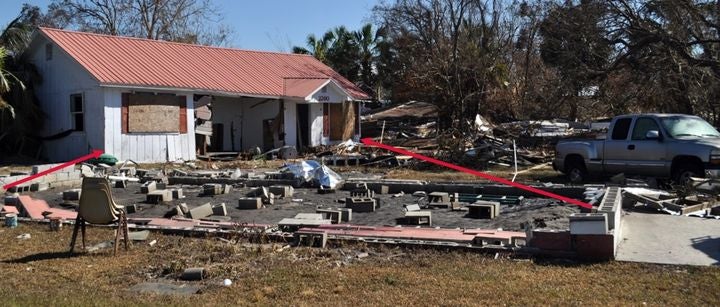
First Floor Height
In areas impacted by high surge waters, particularly in Mexico Beach, buildings with an elevated first floor of eight to ten feet (2.4 to 3 meters) above ground survived (see top of Figure 8), while those with slab-on-grade foundations were washed away (see bottom of Figure 8). However, there were exceptions — some elevated homes were also wiped clean off their raised pile foundations. In several such instances, we were able to ascertain the failure resulted from weak foundation connections between the raised first floor and the columns underneath, which were not adequate to withstand the high wind loads imposed by the storm.
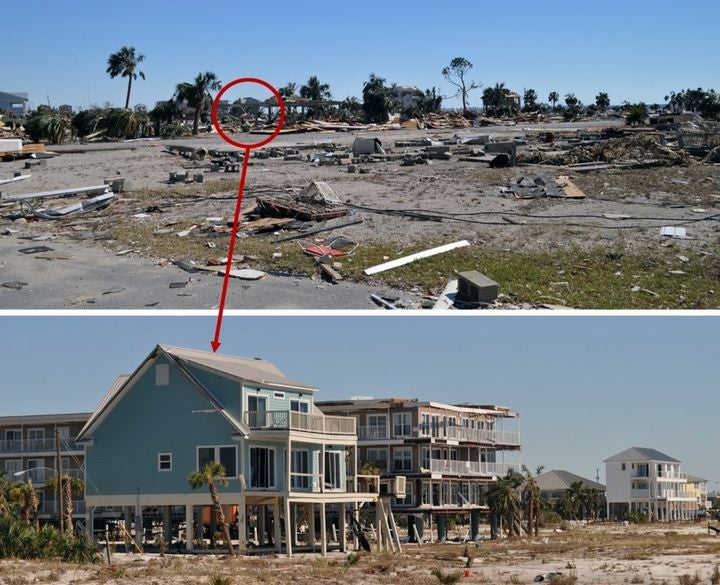
Commercial Structures
Commercial structures in Panama City were significantly damaged. Wind damage was worse on the east side of the town with nearly one out of every two buildings sustaining visible damage. In addition to gas station canopy failures commonly observed after hurricanes, we noted significant damage to offices, retail stores, and entertainment facilities from roof failures and wall collapses. We specifically noted many instances of unreinforced masonry wall failures in this area.
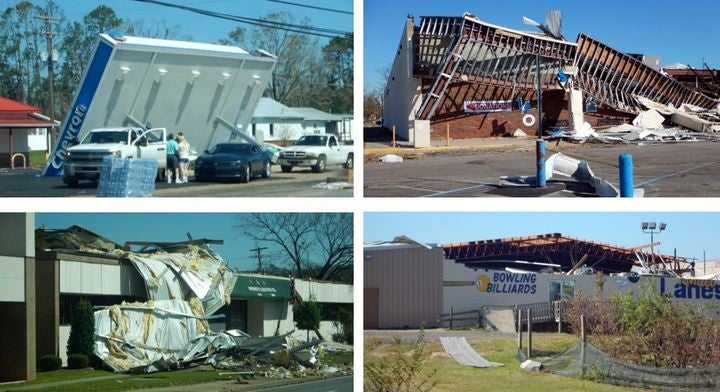
Differences across Georgia and the Florida Panhandle
In addition to the Florida Panhandle, Michael caused significant damage in Georgia. There were notable differences in building attributes across Florida and Georgia. For instance, most homes in rural parts of interior Florida had some type of window protection installed, even if it was just plywood. However, there was hardly any evidence of window protection just across the state border. The installation quality and maintenance of roofs also seemed poorer on average outside Florida. As a result, we observed more roof cover damage in Georgia even at comparable wind speeds.
Conclusions
Many areas in the Florida Panhandle region experienced wind speeds at or above design level in Hurricane Michael. The immediate response of RMS field reconnaissance was instrumental in recording damage observations from both high winds and storm surge experienced in the event. Field observations provided ample evidence that newer buildings in the region built to stricter building code provisions performed better in extreme winds, while older structures experienced severe damaged. The importance of proper foundation design, roof installation methods, and elevated first floors was repeatedly reinforced by damage observations in the surveyed area.
Each hurricane is unique in its impact. With boots on the ground soon after landfall, RMS can identify unique event characteristics as well as recurring themes in damage that are consistent across multiple events and different regions. All of this helps inform the collective knowledge within the RMS model development group to improve, substantiate, and calibrate our vulnerability and hazard models.
